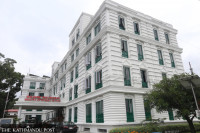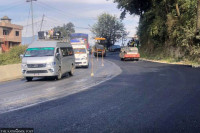National
Nepal Airlines resumes its Osaka flights after a decade but it may fly almost empty
Officials admit that the poor bookings reflect the carrier’s reputation for inefficiency..jpg&w=900&height=601)
Sangam Prasain
In a desperate bid to salvage its image, Nepal Airlines Corporation had attempted to resume flights to Osaka, Japan after more than a decade, but those plans seem to have gone awry. Flights are resuming next week, but only 15 tickets for Kathmandu-Osaka and 18 tickets for Osaka-Kathmandu have been sold so far. At least 30 officials, including Tourism Minister Yogesh Bhattarai, are also flying.
The national flag carrier, which will make its first flight on August 29 to Osaka after 12 years, said that the bookings are “much worse than expected”. After the inaugural flight, not more than eight tickets per flight have been sold for September, according to a top official at the airline told the Post on condition of anonymity because he was not authorised to speak to the media.
[Related Story: Preventing another setback, Tribhuvan Airport will offer short window for Nepal Airlines flight to Japan]
Nepal Airlines was offering one-way flights to Osaka at a throwaway price of Rs36,000, which is 25-30 percent cheaper than the going rate. But even that has failed to attract passengers. Officials admitted that Nepal Airlines’ reputation for inefficiency, a decades-long hallmark of the flag carrier, was behind the lacklustre sales.
“Passengers still doubt whether Nepal Airlines will fly or not, which has affected advance bookings,” said Tanka Nidhi Dahal, the corporation’s commercial director, at a press meet on Tuesday. “It seems like we’ll be facing hardship in September.”
The non-stop seven-hour flight is scheduled to operate three times a week—on Tuesdays, Thursdays and Saturdays—on an Airbus A330 that can accommodate 274 passengers. The flight will depart from Kathmandu at 2:30 am and land in Osaka at 11:55 am local time. The return flight, which will also take six hours, will leave Osaka at 1:55 pm local time and reach Kathmandu at 6:00 pm.
“With the ongoing booking trend, we are expecting at least 100 passengers,” Madan Kharel, executive chairman of the corporation, told mediapersons. “All flights preparations are complete.”
Current booking trends show that the load factor in September will be poor, but October could be better, as many Nepalis are expected to return from Japan for the festival season, said Dahal. October and November are also peak tourist months in Nepal.
In the first week of June, Nepal Airlines had postponed the re-launch of its Osaka service till the end of August due to ‘very poor’ bookings during the low season. Flights to Osaka’s Kansai International Airport were slated to begin on July 4. At that time, the carrier had said that moving flight resumption to September was a risk-mitigating approach, as the airlines could incur heavy losses. The June-August or monsoon period is the off-season for travelling in Nepal. Nepal Airlines used to temporarily suspend its Osaka flights during this time of the year when its Japan service was regular over a decade ago.
The carrier had planned to resume flights to Japan in September last year, but preparations were incomplete, leading to a delay in approval from the Japan Civil Aviation Bureau to use Kansai International Airport. The Japan Civil Aviation Bureau only granted flight authorisation to Nepal Airlines in mid-April.
[Related Story: Nepal Airlines postpones Osaka service due to ‘very poor’ bookings]
Kharel admitted that the decision to open bookings in July was taken in haste. We only realised it later, he said.
“But poor bookings in September don’t mean that we will face the same situation around the year,” said Kharel. “Our target is to achieve 80 percent average annual bookings, which is what we had 12 years ago.” According to Kharel, around 70 percent occupancy will enable a flight to break even.
Despite the dismal state of its Osaka bookings, Kharel said that Nepal Airlines would operate flights to Narita International Airport in Tokyo from January 1.
Nepal Airlines launched its Japan service in 1994, flying to Osaka via Shanghai, China. In 2007, it was forced to suspend the route as it did not have enough planes.
The carrier expects the resumption of its Japan service to help improve its financial health. Nepal Airlines has found itself in the midst of a financial crunch as it has not been able to fly its newly acquired Airbus A330 jets on profitable long routes like Japan and Europe.
Tri Ratna Manandhar, former director general of the Civil Aviation Authority of Nepal, said that the corporation should have signed an agreement ensuring minimum seat guarantees while appointing local agents to sell tickets. “But this doesn’t seem to have happened with a general sales agent or primary sales agents,” he said.
Manandhar said that all inaugural flights are not overbooked and in some cases, airlines could incur losses for months, but the airline should continue regular flights to gain the trust of passengers.
“Carriers normally gain momentum in a new sector after five or six flights,” he said.
Manandhar pointed to a lack of publicity and marketing, which is crucial in the airline business. Kharel too admitted that in terms of publicity and marketing, the corporation is behind but said that they were planning to go digital and take to social media.
Nepal Airlines will be finally opening its Twitter account, said Kharel.




 9.68°C Kathmandu
9.68°C Kathmandu









%20(1).jpg&w=300&height=200)





